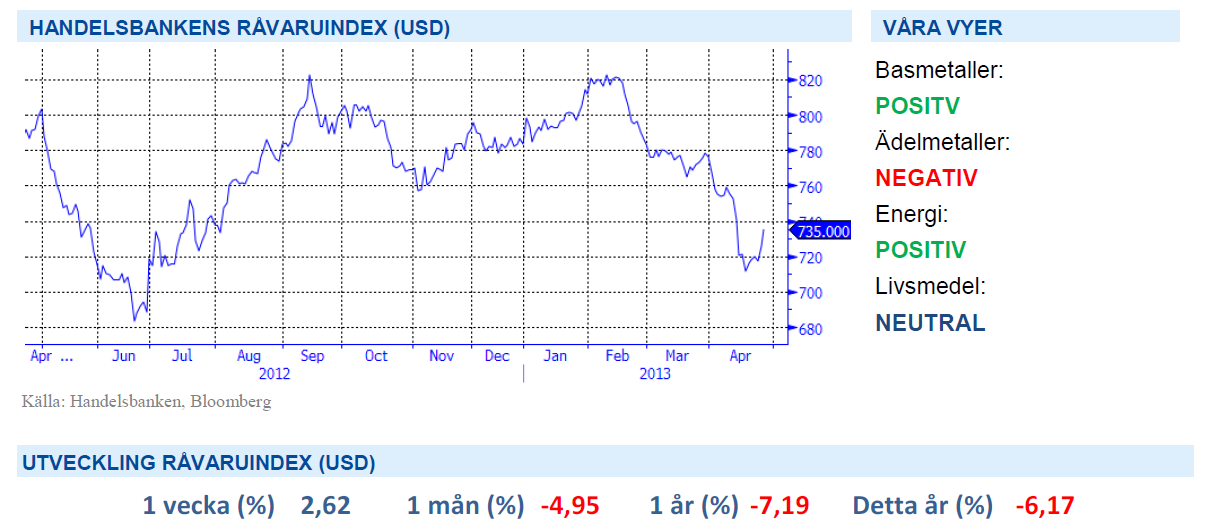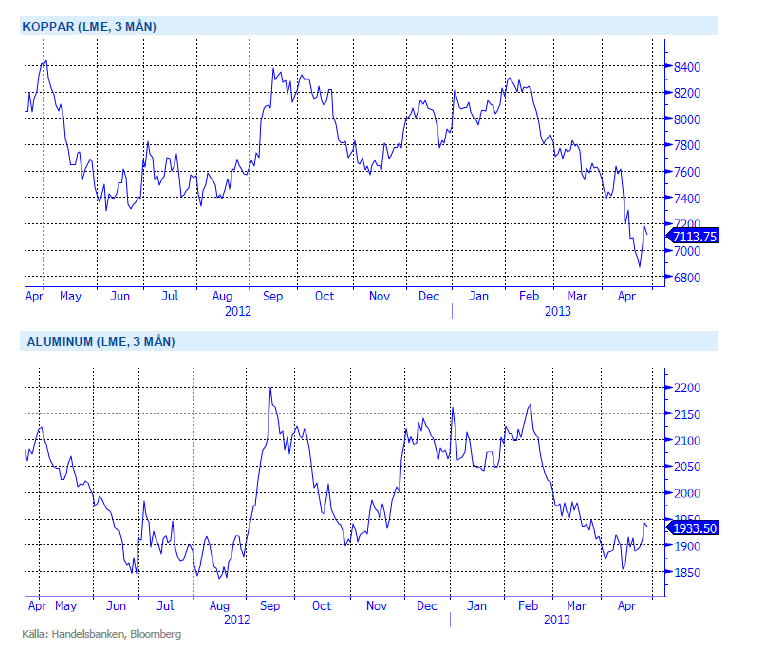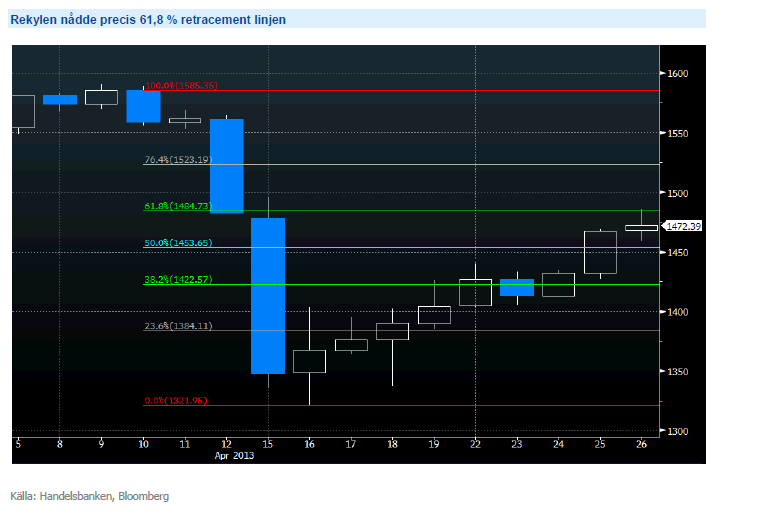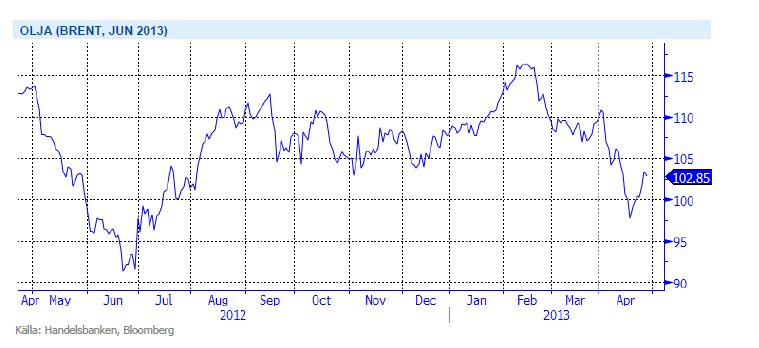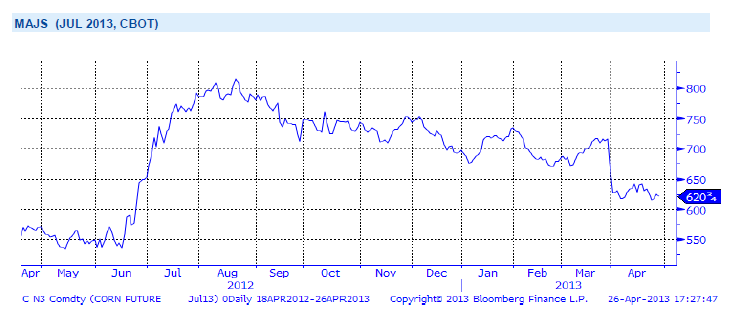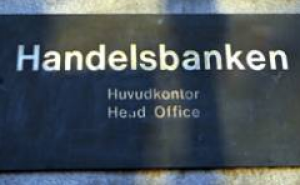Analys
SHB Råvarubrevet 26 april 2013
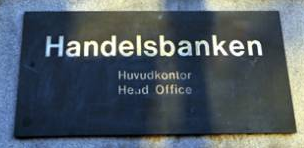
 Råvaror allmänt
Råvaror allmänt
Makrotunga veckor – Råvarorna vänder upp
Denna vecka började med en ny kalldusch, råvarunegativ makrodata. Nu i form av preliminära inköpschefssiffror som från Kina, USA och Tyskland var sämre än väntat. I sällskap av mer dålig makrodata så bidrog dock dataskörden så småningom till att öka förväntningarna på att ECB ska sänka räntan den 2:a maj och det fick i sin tur råvarupriserna att rekylera på bred front under sista delen av veckan. Centralbanksstödet fortsätter, nu med Bank of Japan i förarsätet och vi tror att ECB kommer att haka på inom kort.
Vi tycker generellt att råvarunedgången har varit överdriven givet hur makrodata har utvecklat sig. Flera råvarusektorer är klart köpvärda. Vi väntar dock på att ekonomer och analytiker ska hinna ta till sig den sämre dataskörden och därmed bidra till att förväntansbilden sänks innan vi tror att den stora rekylen uppåt kommer.
Basmetallerna
Stark vecka för basmetallerna
Basmetallerna har blivit väldigt tekniskt handlade i den negativa miljön. Vi har samlat ett antal indikatorer från den fysiska marknaden som ser ganska bra ut och vi tror att basmetaller är den råvarusektor som har störst potential att studsa upp efter vårens ras. Ännu vågar vi dock inte slå på stora trumman utan avvaktar ytterligare dålig makrodata som vi tror ligger i luften.
Basmetallerna har visat på styrka under veckan som gått. Koppar vände på 6854, före senaste årens botten under 2011 på 6635. Aluminium nådde 30-dagars högsta men även nickel och zink har visat på en klar vändning.
Trots fortsatt svag makromiljö och fortsatt risk på nedsidan ser vi ändå basmetaller som köpvärda på dessa nivåer. Vi tror på: LONG BASMET H
Ädelmetaller
Guldet rekylerar upp, har det vänt nu?
Guldet har – tillsammans med de flesta råvaror – rekylerat upp denna vecka. Rekylen har varit ganska kraftig, över 4 % upp sedan förra fredagen, eller 8 % från botten måndagen den 15 april. Det är inget konstigt i det, då guldet föll rekordsnabbt för två veckor sedan, och vi står alltjämt 13 % lägre än början på året. Silver, guldets sprallige lillebror, har också studsat upp, men ligger över 20 % ner på året trots detta. Köpläge eller säljläge?
Vi tror fortfarande att guldets glans falnat en hel del, det ska studsa lite efter ett så kraftigt fall vi såg för två veckor sedan, och nu hör vi tal om att centralbanker världen över köpt guld senaste veckan. Det är värt att påminna om att centralbanker som har bestämmelser om hur stor andel av reserverna som ska ligga i guld de facto MÅSTE köpa guld när det har fallit så kraftigt, annars minskar guldets andel i reserven. Omvänt måste de sälja om priset stiger.
Guldets huvudproblem kvarstår, alla som köper gör det för att sälja dyrare, alltså även världens centralbanker. Centralbankerna har dock lyxen att slippa sälja när priset faller. Åtminstone tills någon säger att man ska minska sin andel guld i reserven.
Köp inte guld. För den som är tekniskt intresserad kan nämnas att rekylen nu vände på exakt 61,8 % retracement, en viktig s.k. Fibonacci-nivå.
Trots det största raset på 30 år tror vi att förtroendet för guld håller på urholkas och att trenden nedåt fortsätter. Vi tror på: SHRT GULD H
Energi
Brent oljan över 100 dollar igen
Priset på el har under veckan fortsatt att stiga efter nedgången från föregående vecka. Variationer i väderprognoser och nyheter kring utsläppsrätterna har varit i fokus denna vecka. På väderfronten gav prognoser med torrare och kallare väder stöd åt elpriset veckans första dagar. Nya prognoser med mer nederbörd än normalt fick priset att falla tillbaka något. För utsläppsrätterna verkar det som de blir en ny omröstning i slutet på juli om den s.k. backloadingplanen. Under veckan har det även auktionerats ut hela 25 miljoner rätter (!), vilket marknaden ändå klarat av förhållandevis bra. Veckan bjöd även på besked om att ministerrådet följer parlamentets beslut att integrera flygtrafik in och ur EU i systemet för handel med utsläppsrätter.
Oljepriset har också studsat under veckan. OPEC har dragit ner produktionen under året och bidrar till att stabilisera priset. Q2 är säsongsmässigt en svag period då många raffinaderier går in i underhåll efter mellan vintern och sommarens högproduktion. Under hösten har Nordsjön har också stabiliserat produktionen efter de låga nivåerna.
OPEC har tidigare aktivt och framgångsrikt försvarat prismålet 100-110 USD och vi väntar oss handling snarare än besked från kartellen inom kort. Konfliken mellan Israel och Iran är nästa skäl att förvänta sig högre oljepriser under H2. Vi tror på: LONG OLJA H
Livsmedel
Bättre väder för sådden i USA
Priserna på majs i Chicago har gått ned under veckan, delvis som följd av förbättrad väderlek för den amerikanska majssådden. Fortfarande faller en del småskurar men temperaturen har stigit och den relativt sena sådden kan nu öka i takt, liknande förhållanden ser ut att råda åtminstone en bit in i nästa vecka. Än finns det gott om tid kvar och inga skäl att tro på annat än en väldigt stark återhämtning för den amerikanska majsproduktionen efter förra årets torka. Globala majsproduktionen för säsongen 2013/14 uppskattar International Grains Council, IGC, till 939 miljoner ton, att jämföra med 851 miljoner ton innevarande säsong – upp drygt 10 procent.
Priserna på sojabönor i Chicago noteras ned sedan förra veckan. I dagsläget är det svårt att tro på annat än en ökad sojaproduktion i USA för nästa säsong, vilket tillsammans med ökad produktion även i andra delar av världen bör ge press nedåt på priset längre fram på året. International Grains Council, IGC, upp skattar kommande säsongs globala sojaskörd till 265 miljoner ton, drygt 10 procent upp från innevarande säsong. Även bättre väder för den fortsatta sojasådden i USA, tillsammans med vikande amerikanska exportsiffror, har gett press nedåt på priset.
Då priserna har på de stora jordbruksråvarorna soja, majs och vete har fallit tillbaka till nivåer före torkan i USA, tror vi att en nedsida är begränsad på kort sikt och därför är vi neutrala till utvecklingen för denna sektor.
Handelsbankens Råvaruindex
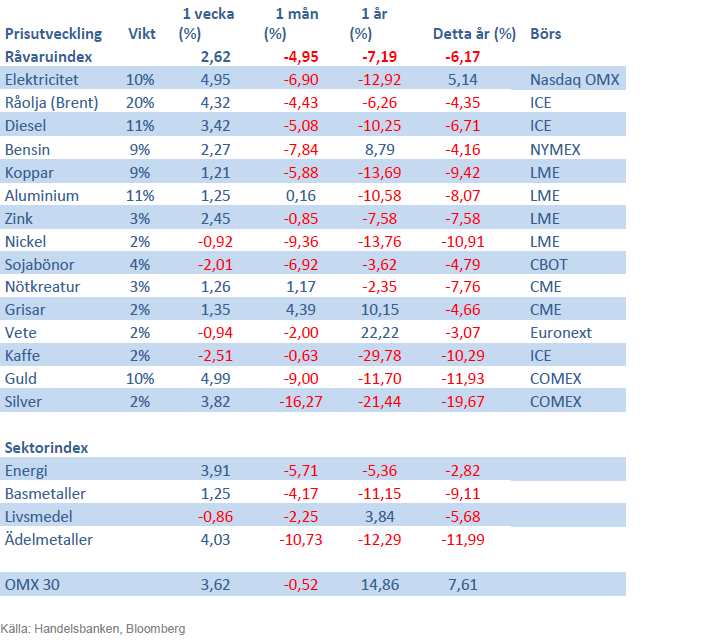
Handelsbankens råvaruindex består av de underliggande indexen för respektive råvara. Vikterna är bestämda till hälften från värdet av global produktion och till hälften från likviditeten i terminskontrakten.
[box]SHB Råvarubrevet är producerat av Handelsbanken och publiceras i samarbete och med tillstånd på Råvarumarknaden.se[/box]
Ansvarsbegränsning
Detta material är producerat av Svenska Handelsbanken AB (publ) i fortsättningen kallad Handelsbanken. De som arbetar med innehållet är inte analytiker och materialet är inte oberoende investeringsanalys. Innehållet är uteslutande avsett för kunder i Sverige. Syftet är att ge en allmän information till Handelsbankens kunder och utgör inte ett personligt investeringsråd eller en personlig rekommendation. Informationen ska inte ensamt utgöra underlag för investeringsbeslut. Kunder bör inhämta råd från sina rådgivare och basera sina investeringsbeslut utifrån egen erfarenhet.
Informationen i materialet kan ändras och också avvika från de åsikter som uttrycks i oberoende investeringsanalyser från Handelsbanken. Informationen grundar sig på allmänt tillgänglig information och är hämtad från källor som bedöms som tillförlitliga, men riktigheten kan inte garanteras och informationen kan vara ofullständig eller nedkortad. Ingen del av förslaget får reproduceras eller distribueras till någon annan person utan att Handelsbanken dessförinnan lämnat sitt skriftliga medgivande. Handelsbanken ansvarar inte för att materialet används på ett sätt som strider mot förbudet mot vidarebefordran eller offentliggörs i strid med bankens regler.
Analys
Tightening fundamentals – bullish inventories from DOE

The latest weekly report from the US DOE showed a substantial drawdown across key petroleum categories, adding more upside potential to the fundamental picture.

Commercial crude inventories (excl. SPR) fell by 5.8 million barrels, bringing total inventories down to 415.1 million barrels. Now sitting 11% below the five-year seasonal norm and placed in the lowest 2015-2022 range (see picture below).
Product inventories also tightened further last week. Gasoline inventories declined by 2.1 million barrels, with reductions seen in both finished gasoline and blending components. Current gasoline levels are about 3% below the five-year average for this time of year.
Among products, the most notable move came in diesel, where inventories dropped by almost 4.1 million barrels, deepening the deficit to around 20% below seasonal norms – continuing to underscore the persistent supply tightness in diesel markets.
The only area of inventory growth was in propane/propylene, which posted a significant 5.1-million-barrel build and now stands 9% above the five-year average.
Total commercial petroleum inventories (crude plus refined products) declined by 4.2 million barrels on the week, reinforcing the overall tightening of US crude and products.


Analys
Bombs to ”ceasefire” in hours – Brent below $70

A classic case of “buy the rumor, sell the news” played out in oil markets, as Brent crude has dropped sharply – down nearly USD 10 per barrel since yesterday evening – following Iran’s retaliatory strike on a U.S. air base in Qatar. The immediate reaction was: “That was it?” The strike followed a carefully calibrated, non-escalatory playbook, avoiding direct threats to energy infrastructure or disruption of shipping through the Strait of Hormuz – thus calming worst-case fears.

After Monday morning’s sharp spike to USD 81.4 per barrel, triggered by the U.S. bombing of Iranian nuclear facilities, oil prices drifted sideways in anticipation of a potential Iranian response. That response came with advance warning and caused limited physical damage. Early this morning, both the U.S. President and Iranian state media announced a ceasefire, effectively placing a lid on the immediate conflict risk – at least for now.
As a result, Brent crude has now fallen by a total of USD 12 from Monday’s peak, currently trading around USD 69 per barrel.
Looking beyond geopolitics, the market will now shift its focus to the upcoming OPEC+ meeting in early July. Saudi Arabia’s decision to increase output earlier this year – despite falling prices – has drawn renewed attention considering recent developments. Some suggest this was a response to U.S. pressure to offset potential Iranian supply losses.
However, consensus is that the move was driven more by internal OPEC+ dynamics. After years of curbing production to support prices, Riyadh had grown frustrated with quota-busting by several members (notably Kazakhstan). With Saudi Arabia cutting up to 2 million barrels per day – roughly 2% of global supply – returns were diminishing, and the risk of losing market share was rising. The production increase is widely seen as an effort to reassert leadership and restore discipline within the group.
That said, the FT recently stated that, the Saudis remain wary of past missteps. In 2018, Riyadh ramped up output at Trump’s request ahead of Iran sanctions, only to see prices collapse when the U.S. granted broad waivers – triggering oversupply. Officials have reportedly made it clear they don’t intend to repeat that mistake.
The recent visit by President Trump to Saudi Arabia, which included agreements on AI, defense, and nuclear cooperation, suggests a broader strategic alignment. This has fueled speculation about a quiet “pump-for-politics” deal behind recent production moves.
Looking ahead, oil prices have now retraced the entire rally sparked by the June 13 Israel–Iran escalation. This retreat provides more political and policy space for both the U.S. and Saudi Arabia. Specifically, it makes it easier for Riyadh to scale back its three recent production hikes of 411,000 barrels each, potentially returning to more moderate increases of 137,000 barrels for August and September.
In short: with no major loss of Iranian supply to the market, OPEC+ – led by Saudi Arabia – no longer needs to compensate for a disruption that hasn’t materialized, especially not to please the U.S. at the cost of its own market strategy. As the Saudis themselves have signaled, they are unlikely to repeat previous mistakes.
Conclusion: With Brent now in the high USD 60s, buying oil looks fundamentally justified. The geopolitical premium has deflated, but tensions between Israel and Iran remain unresolved – and the risk of missteps and renewed escalation still lingers. In fact, even this morning, reports have emerged of renewed missile fire despite the declared “truce.” The path forward may be calmer – but it is far from stable.
Analys
A muted price reaction. Market looks relaxed, but it is still on edge waiting for what Iran will do

Brent crossed the 80-line this morning but quickly fell back assigning limited probability for Iran choosing to close the Strait of Hormuz. Brent traded in a range of USD 70.56 – 79.04/b last week as the market fluctuated between ”Iran wants a deal” and ”US is about to attack Iran”. At the end of the week though, Donald Trump managed to convince markets (and probably also Iran) that he would make a decision within two weeks. I.e. no imminent attack. Previously when when he has talked about ”making a decision within two weeks” he has often ended up doing nothing in the end. The oil market relaxed as a result and the week ended at USD 77.01/b which is just USD 6/b above the year to date average of USD 71/b.

Brent jumped to USD 81.4/b this morning, the highest since mid-January, but then quickly fell back to a current price of USD 78.2/b which is only up 1.5% versus the close on Friday. As such the market is pricing a fairly low probability that Iran will actually close the Strait of Hormuz. Probably because it will hurt Iranian oil exports as well as the global oil market.
It was however all smoke and mirrors. Deception. The US attacked Iran on Saturday. The attack involved 125 warplanes, submarines and surface warships and 14 bunker buster bombs were dropped on Iranian nuclear sites including Fordow, Natanz and Isfahan. In response the Iranian Parliament voted in support of closing the Strait of Hormuz where some 17 mb of crude and products is transported to the global market every day plus significant volumes of LNG. This is however merely an advise to the Supreme leader Ayatollah Ali Khamenei and the Supreme National Security Council which sits with the final and actual decision.
No supply of oil is lost yet. It is about the risk of Iran closing the Strait of Hormuz or not. So far not a single drop of oil supply has been lost to the global market. The price at the moment is all about the assessed risk of loss of supply. Will Iran choose to choke of the Strait of Hormuz or not? That is the big question. It would be painful for US consumers, for Donald Trump’s voter base, for the global economy but also for Iran and its population which relies on oil exports and income from selling oil out of that Strait as well. As such it is not a no-brainer choice for Iran to close the Strait for oil exports. And looking at the il price this morning it is clear that the oil market doesn’t assign a very high probability of it happening. It is however probably well within the capability of Iran to close the Strait off with rockets, mines, air-drones and possibly sea-drones. Just look at how Ukraine has been able to control and damage the Russian Black Sea fleet.
What to do about the highly enriched uranium which has gone missing? While the US and Israel can celebrate their destruction of Iranian nuclear facilities they are also scratching their heads over what to do with the lost Iranian nuclear material. Iran had 408 kg of highly enriched uranium (IAEA). Almost weapons grade. Enough for some 10 nuclear warheads. It seems to have been transported out of Fordow before the attack this weekend.
The market is still on edge. USD 80-something/b seems sensible while we wait. The oil market reaction to this weekend’s events is very muted so far. The market is still on edge awaiting what Iran will do. Because Iran will do something. But what and when? An oil price of 80-something seems like a sensible level until something do happen.
-

 Nyheter3 veckor sedan
Nyheter3 veckor sedanStor uppsida i Lappland Guldprospekterings aktie enligt analys
-

 Nyheter4 veckor sedan
Nyheter4 veckor sedanBrookfield ska bygga ett AI-datacenter på hela 750 MW i Strängnäs
-

 Nyheter3 veckor sedan
Nyheter3 veckor sedanSilverpriset släpar efter guldets utveckling, har mer uppsida
-

 Nyheter4 veckor sedan
Nyheter4 veckor sedanTradingfirman XTX Markets bygger datacenter i finska Kajana för 1 miljard euro
-

 Nyheter2 veckor sedan
Nyheter2 veckor sedanUppgången i oljepriset planade ut under helgen
-

 Nyheter2 veckor sedan
Nyheter2 veckor sedanLåga elpriser i sommar – men mellersta Sverige får en ökning
-

 Analys2 veckor sedan
Analys2 veckor sedanVery relaxed at USD 75/b. Risk barometer will likely fluctuate to higher levels with Brent into the 80ies or higher coming 2-3 weeks
-

 Nyheter1 vecka sedan
Nyheter1 vecka sedanMahvie Minerals växlar spår – satsar fullt ut på guld


